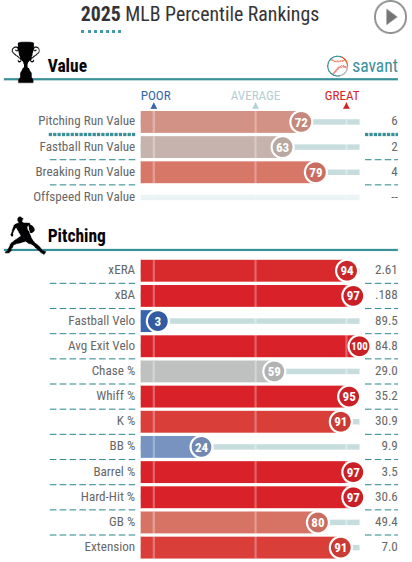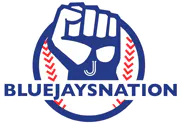Meaningful upgrade(s) to Blue Jays’ staff may need to arrive via bullpen given sparse starters’ market

Photo credit: Ken Blaze-Imagn Images
By Thomas Hall
Jul 22, 2025, 15:00 EDTUpdated: Jul 22, 2025, 14:58 EDT
With the July 31 trade deadline just over a week away, it’s becoming increasingly clear that acquiring an impact starting pitcher — one capable of leading the Toronto Blue Jays’ rotation beyond this season — may not be as feasible as the front office probably would’ve hoped based on what’s available, or lack thereof.
Barring a last-minute surprise, it doesn’t appear the likes of Joe Ryan, Jacob deGrom, Freddy Peralta, or MacKenzie Gore will be moved between now and next Thursday’s 6 p.m. ET deadline. That’ll make raising the ceiling of Toronto’s rotation significantly more challenging, if not next-to-impossible.
The rental market does feature a few upside arms, such as Zac Gallen, Merrill Kelly and Seth Lugo (2026 player option). But none of them drasticaly moves the needle forward for this club. At this point, with few high-impact starters available, management’s clearest pathway to significantly upgrading its pitching staff may lie in the bullpen rather than the rotation.
Granted, the Blue Jays already possess a solid group of relievers, which are tied for 10th in fWAR (2.9) amongst major league bullpens this season. But they’re currently shorthanded with Yimi García (ankle, elbow) and Nick Sandlin (elbow) each on the IL for the second time this season, and Ryan Burr (shoulder) out for the remainder of the year.
Both García and Sandlin are expected to return sometime in August, fortifying the back end of the ‘pen that includes closer Jeff Hoffman as well as Yariel Rodríguez, Brendon Little and Braydon Fisher. To shorten games down the stretch and in October, though, they could use another high-leverage arm or two.
Unlike the starting pitching market, there seems to be plenty of impact potential up for grabs, so much so that we can divide the reliever market into three separate availability tiers.
High-Cost Controllables
Plucking a reliever from this group will surely cost a premium.
This is where you’ll find the likes of Emmanuel Clase, Cade Smith, Jhoan Duran and Griffin Jax. Any one of these arms would be a game-changer for Toronto’s bullpen, transforming it into one of the American League’s premier units.
Clase or Duran, in particular, would fit perfectly alongside Hoffman, Rodríguez and García (when healthy) as options to pitch in save situations. However, those two would also likely feature the highest acquisition cost, given their closing experience and amount of club control beyond ’25.
For Clase, the Guardians’ closer is signed for one more season at $6.4 million and features $10 million club options ($2 million buyout) in 2027 and ’28. Meanwhile, the Twins’ primary ninth-inning hurler owns two additional arbitration years before entering free agency after the ’27 campaign.
In either case, Cleveland and Minnesota would need to receive an overwhelming offer to entice either club to part with their current closer, meaning they’re both likely staying put. But never say never.
Alternatively, the Blue Jays would be a great spot if they came away with Jax — whose strikeout (37.9 per cent), whiff (39.8 per cent) and chase rates (41.2 per cent) rank in the 99th percentile or higher this season — or Smith following this season’s deadline.
The Abbotsford, B.C., native will likely be more expensive of the two, considering he isn’t arbitration-eligible until ’27 and won’t hit free agency until after the ’29 campaign. In comparison, the Twins’ setup man owns two additional seasons of club control via arbitration before hitting the open market.
Two other arms that should fall under this tier are Pittsburgh’s David Bednar and Dennis Santana, both of whom are free agents after next season. If all four relievers above prove too lucrative, either of these two could provide a more cost-effective solution for the Blue Jays, particularly the Pirates’ closer, a subject of trade rumours over the past several years.
Notable Rentals
There aren’t as many impact relievers available in this year’s class of pending free agents as there have been in previous seasons, and that’s a main reason why arms in the tier above have received a ton of interest thus far. There’s still a meaningful addition to be found in this part of the market, though.
St. Louis’ Ryan Helsley and Atlanta’s Raisel Iglesias sit atop the market for rental relievers. Both hurlers feature somewhat of a high salary this season, earning $8.2 million and $16 million, respectively. That means either club may have to include cash via trade to increase their odds of netting a larger return.
Helsley’s trade value isn’t what it once was due to his production decline, with his strikeout rate dropping five per cent and his HR/9 jumping from 0.41 to 1.06 compared to last season, when he accounted for a career-high 2.3 fWAR — down to 0.3 this season. Still, the 31-year-old throws one of the hardest fastballs in the sport, thanks to its 99th percentile average velocity (99.3 m.p.h.), and pairs it with a knee-breaking slider.
Despite sporting a 5.12 ERA and minus-0.2 fWAR in 41 appearances this season, Iglesias has turned the corner over the past month-plus, tossing 13.2 scoreless innings with 18 strikeouts and only one walk since June 9. That remarkable streak came to an end in his latest outing against the New York Yankees, who tagged him for four runs (all earned) on Saturday.
But as someone with 78 total saves since 2023, the sixth-most in the majors during that span, one spot behind Helsley (82) for fifth, this recent sample size from Iglesias has reignited his status as a dependable high-leverage reliever during his age-35 season.
Baltimore’s bullpen also includes a pair of high-upside rentals: Gregory Soto and Seranthony Domínguez. The first of that duo could garner more interest from Toronto’s front office, which may lean towards adding another lefty in the bullpen, particularly one that owns a 21.9-per-cent strikeout-to-walk rate difference (K-BB%) versus left-handed batters this season. That being said, you can’t go wrong with either in terms of targeting high velocity and swing-and-miss.
Another potential rental to consider is Cincinnati’s Emilio Pagán. The Reds remain alive in the NL wild-card race, entering Tuesday’s slate 3.5 games back of the final playoff spot. If they fall out of contention, though, the 34-year-old closer could become an impact under-the-radar acquisition with his 91st percentile strikeout rate (30.9 per cent) — the type of arm that teams may regret passing on when the post-season arrives.
Low Cost, High Reward Potential
Perhaps there’s a hidden gem located in this part of the market.
Oftentimes, it’s not the flashy acquisition that ends up making the most meaningful impact during the post-season — think of the New York Mets beefing up last season’s bullpen with Ryne Stanek and Phil Maton, who may be on the move again at this year’s trade deadline.
For the Blue Jays to add as much upside to their bullpen as possible, they’ll have to work creatively amidst an extreme sellers’ market, which could mean a bit of bargain hunting. And there are a few arms that should be on their radar.
Let’s start with Shelby Miller, who’s on an expiring one-year, $1-million contract. While the 34-year-old is currently on the IL with a forearm injury, he’s inching towards beginning a rehab assignment and should return fairly soon. Prior to hitting the shelf, the veteran righty had recorded a career-high 10 saves for an injury-riddled D-backs bullpen while producing a 97th percentile chase rate (35.8 per cent).
Though Miller is unlikely to sustain his 1.98 ERA, as evidenced by his 3.12 FIP and 3.22 xERA, his fastball-splitter combo — capable of retiring both righties and lefties — would fit seamlessly in Toronto’s bullpen.
If the Cardinals decide to sell, acquiring Maton may actually present more bang for your buck than Helsley. Just examine the results. On top of his 2.48 ERA, 2.51 FIP and career-high (excluding 2020) 21.1-per-cent K-BB%, his Baseball Savant player card is covered in bright red despite his below-90s fastball velocity.

Source: Baseball Savant
That’s because of how well Maton can spin the ball with his four-pitch arsenal — curveball, cutter, sweeper, sinker — that allows him to attack every quadrant of the strike zone and change speeds effectively. And on a one-year, $2-million deal, he’s been a bargain for St. Louis.
Here’s another one for you: Shawn Armstrong. You’re probably saying, “Who?” The 34-year-old signed a one-year, $1.25-million contract with Texas over the off-season and has quietly impressed, pitching to a 3.05 ERA, 3.54 FIP and 16.2-per-cent K-BB% with three saves across 44.1 innings.
Armstrong mostly thrives in minimizing hard contact — 89th percentile hard-hit rate against (33.9 per cent) — but he could unlock more swing-and-miss and chase with a few pitch usage tweaks, throwing fewer fastballs — he owns three of them, four-seamer, cutter and sinker — and more curveballs.
Breaking News
- Blue Jays: 3 potential trade partners for Jose Berrios
- The Blue Jays need a bounceback campaign from Anthony Santander in 2026
- Blue Jays: A Spring Training battle appears to be brewing between Eric Lauer and Cody Ponce
- 3 questions that remain unanswered from the Blue Jays’ early offseason moves
- Report: Phillies sign Brad Keller to two-year deal
